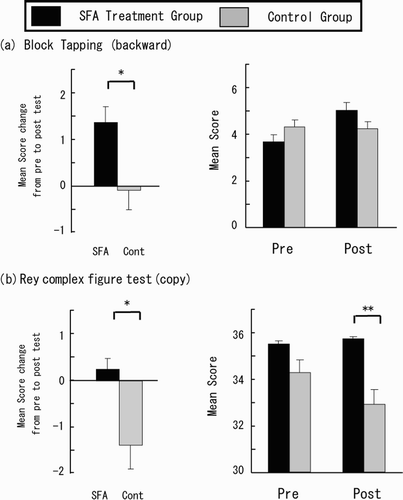Figures & data
Figure 1. Materials and procedures used in the SFA programme. (a): An example of a floral arrangement pattern. (b): Materials used in the SFA. (c): A polygonal shaped absorbent sponge with impressions of various shapes: overall view (left) and overhead view (right). (d): Floral arrangement pattern (left) and diagram of the absorbent sponge (right). This was provided in the instruction sheet as the second stage of the floral arrangement task. The circles and triangles correspond to the impressions on the sponge (c: right). The shapes are a guide to which materials should be placed; the materials were placed vertically to the plane of the shaped sponge (e.g., four lateral roses were placed on the 45-degree angled plane of the sponge marked by a circle). The numbers denote the sequence in which the items were to be placed (right). On the basis of the diagrams in the instruction sheet, the participants were able to identify the placement position for each item, which they memorised temporarily, and subsequently followed step-by-step. Finally, after placing three types of materials (roses, carnations, and variegated leaves) on predetermined positions, small leaves and/or flowers were arranged randomly to fill up the remaining area on the absorbent sponge. [To view this figure in colour, please visit the online version of this Journal.]
![Figure 1. Materials and procedures used in the SFA programme. (a): An example of a floral arrangement pattern. (b): Materials used in the SFA. (c): A polygonal shaped absorbent sponge with impressions of various shapes: overall view (left) and overhead view (right). (d): Floral arrangement pattern (left) and diagram of the absorbent sponge (right). This was provided in the instruction sheet as the second stage of the floral arrangement task. The circles and triangles correspond to the impressions on the sponge (c: right). The shapes are a guide to which materials should be placed; the materials were placed vertically to the plane of the shaped sponge (e.g., four lateral roses were placed on the 45-degree angled plane of the sponge marked by a circle). The numbers denote the sequence in which the items were to be placed (right). On the basis of the diagrams in the instruction sheet, the participants were able to identify the placement position for each item, which they memorised temporarily, and subsequently followed step-by-step. Finally, after placing three types of materials (roses, carnations, and variegated leaves) on predetermined positions, small leaves and/or flowers were arranged randomly to fill up the remaining area on the absorbent sponge. [To view this figure in colour, please visit the online version of this Journal.]](/cms/asset/e86d15dd-1158-413b-95c5-0b0d49559e98/pnrh_a_472036_o_f0001g.jpg)
TABLE 1
Characteristics of SFA and Control Groups
Figure 2. Sample of floral arrangements made by the same participant in the second (a) and fourth (b) day sessions. According to the instruction sheets, participants were required to arrange four carnations (a) and roses (b) in a square shape like the line. Although the carnations were not arranged in a square shape (a), the roses were arranged in good order (b). [To view this figure in colour, please visit the online version of this Journal.]
![Figure 2. Sample of floral arrangements made by the same participant in the second (a) and fourth (b) day sessions. According to the instruction sheets, participants were required to arrange four carnations (a) and roses (b) in a square shape like the line. Although the carnations were not arranged in a square shape (a), the roses were arranged in good order (b). [To view this figure in colour, please visit the online version of this Journal.]](/cms/asset/b801d0c7-0971-4696-b250-e4e5811f7c56/pnrh_a_472036_o_f0002g.jpg)
